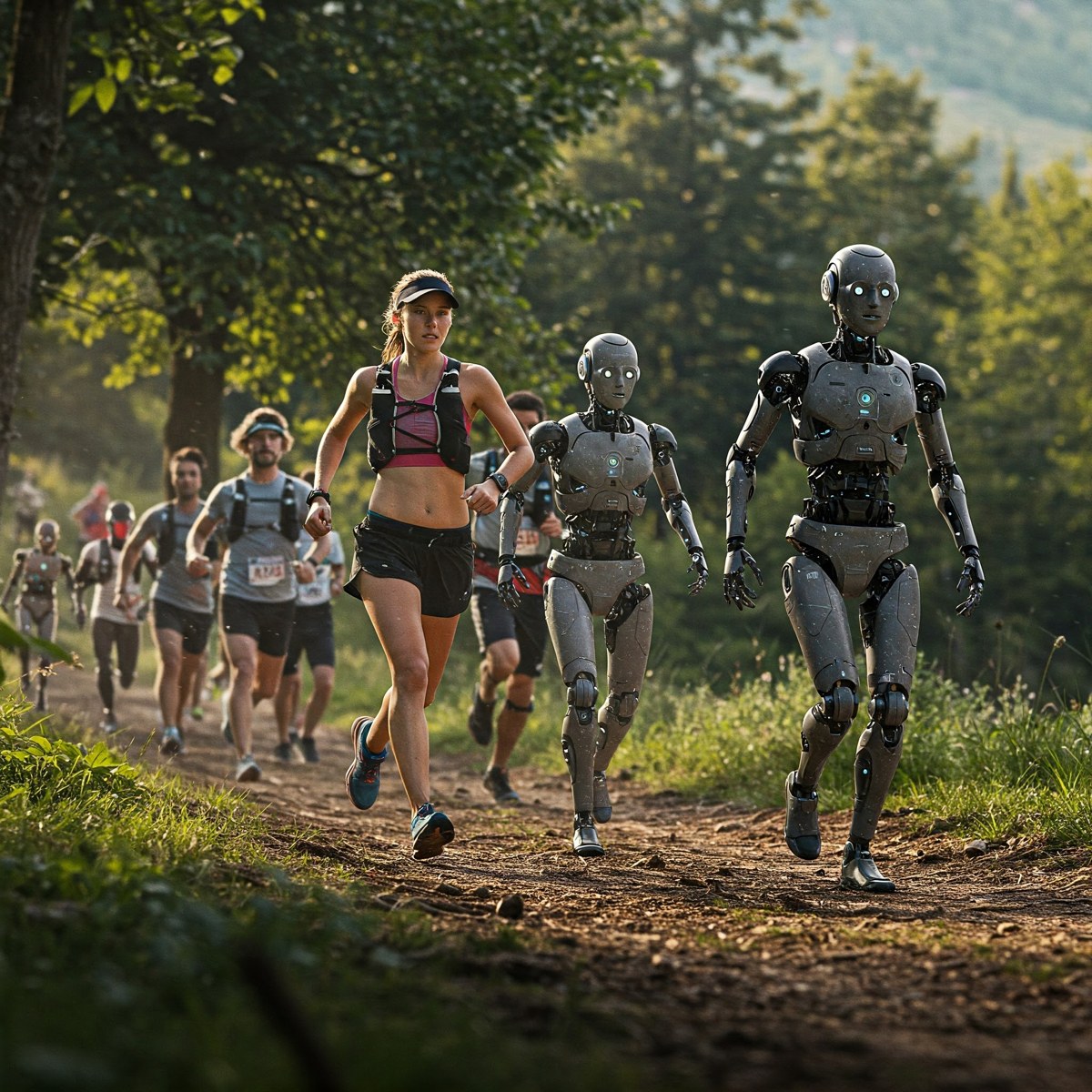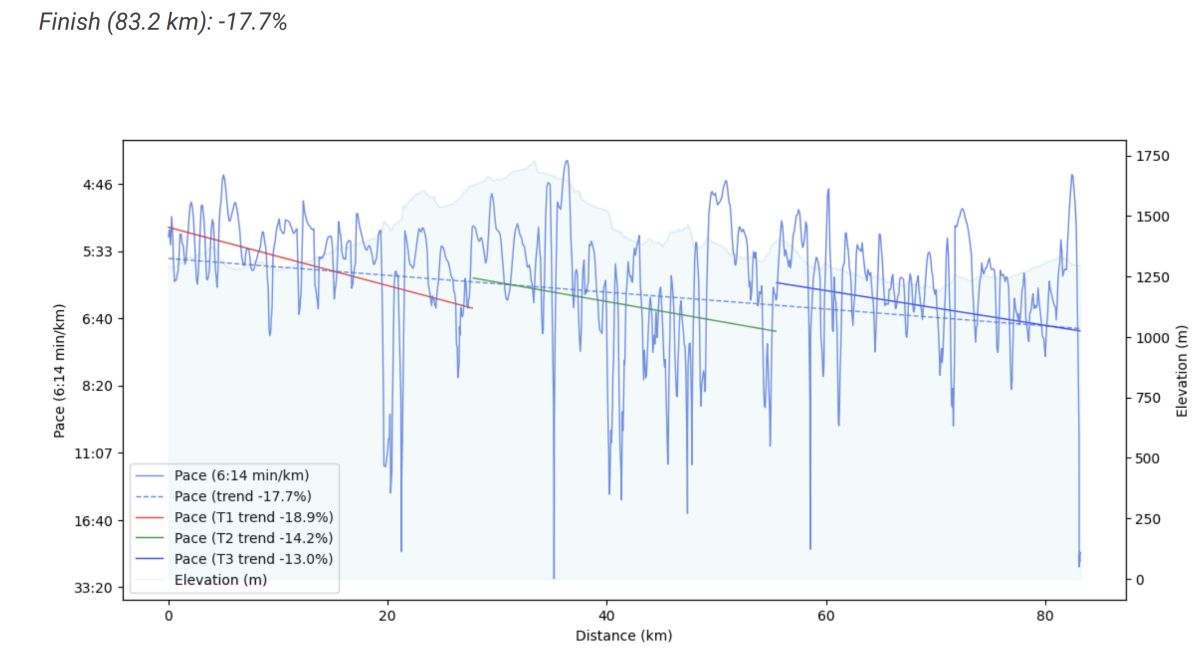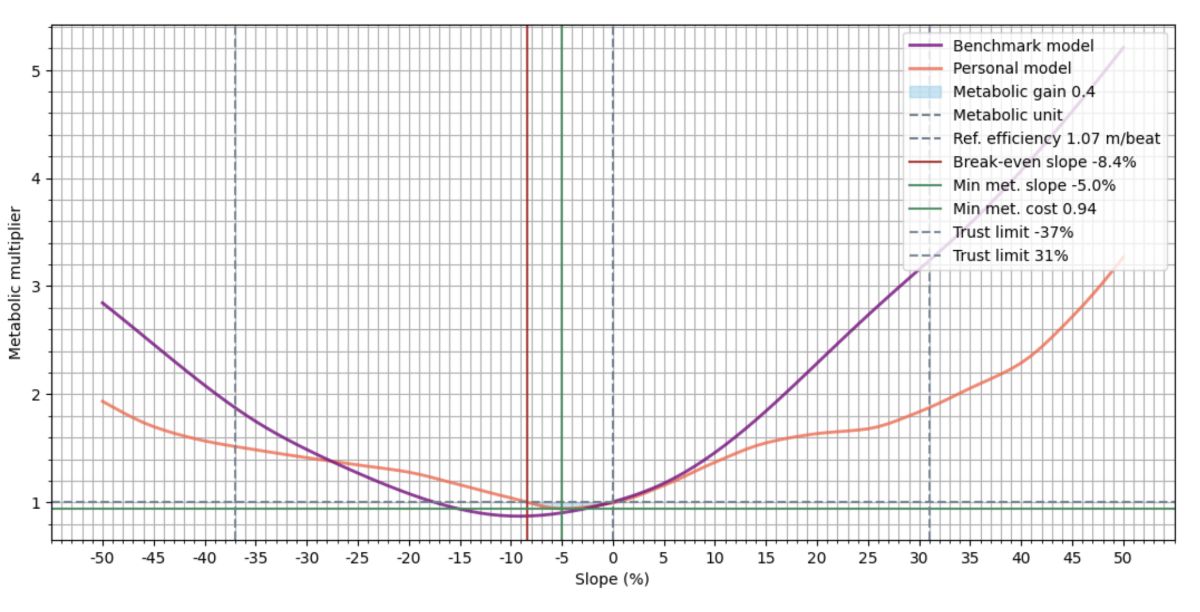As the sport and industry of trail running grow, so do the opportunities for disruption by artificial intelligence (AI). We understand if you’re tired of hearing about AI, but as a column focused on data analysis, we’d be remiss if we didn’t explore how new advancements are shifting the role of technology in trail running.
AI is a broad field of computer science that has been around for many decades, but recently burst into the limelight with the release of generative AI models. At its core, AI identifies patterns and uses them to make predictions. The generative large language models, such as ChatGPT, are good at predicting the next word in a sentence and can write beautiful articles like this one. (Just kidding, everything here is 100% human!) In this article, we look at how advancements in generative AI models will impact the trail running space.
The current benefits of AI are mainly seen in automating basic tasks — making experts’ workflows more efficient. Most of our use cases emphasize ways AI tools can enhance the efficiency of people working in the industry, saving us time when industry professionals compile datasets, create media content, or draft emails or training plans. As the field of AI continues to advance, there might be broader implications as the models become capable of matching human experts’ accuracy, logic, judgments, and originality.

This is not what we mean when we talk about the impact of AI in trail running, it’s just a fun image. Image generated in Gemini by Bryon Powell.
While this column frequently uses quantitative datasets to inform our writing, this time we’ll be referencing broader trends and specific use cases. AI is relevant to our interest in running data, because its models consume datasets of all kinds to inform their outputs. In fact, there’s a solid chance that multiple bots, crawling the internet looking for content, will scrape this very article to add to their respective AI models. Hi, bots!
There is so much that could be said about AI — even just with respect to trail running and ultrarunning — without asking a generative AI model to help. We will only scratch the surface of the AI conversation here. We welcome additional observations, predictions, and perspectives in the comments.
Artificial Intelligence Primer
AI models ingest vast amounts of data to learn patterns and then use that information to make predictions. Generative models use the data to generate new content, and recent advancements have led to breakthroughs in creating more complex outputs. In 2022, the company OpenAI launched ChatGPT, which has allowed for widespread adoption of generative AI to assist with tasks that include but are not limited to writing school papers, drafting emails, consolidating and editing written pieces, and producing mostly bad and sometimes hilarious creative works. We will not dive into the full history of generative AI, but if you are interested, here is an article that does.
Since the launch of ChatGPT, the race to train larger and more complex models has escalated quickly, with multiple large firms pushing the frontier forward. This innovation has brought about rapid technological advancement, which carries various negative implications as well. In their race for an edge, the firms’ AI systems are consuming large amounts of computing power and electricity as they attempt to train models that are pushing costs of over $100 million. These models are trained on data, and this data is often scraped from wherever possible without permission from the original creators or respect for copyright.
The generative large language models have become extremely powerful, but they are ultimately models that make predictions based on training data and prior words, which often leads to factually inaccurate results. While generative AI isn’t replacing experts with its current capabilities, it is disrupting many industries and professions, with the potential result of eliminating jobs or dramatically altering how certain jobs are performed.
“The New Yorker” recently published an article, “How to Survive the A.I. Revolution,” that discusses the unknown but changing landscape AI will bring. There are both alarmists and evangelists about the future of AI, but one thing is clear, it will bring change. Understanding the direction AI is headed in and helping shape its path will be critical in determining the impact of AI in the trail running industry.
Content Creation
If you hate-read this column, you’ll take some pleasure in knowing that we spend a significant amount of time collecting and cleaning data for each piece. From this data, we extract insights and write lovely articles. Generative AI models are quite good with words, but still leave much to be desired on the numbers front. Most of the advancements in content creation are seen in the realm of completing burdensome tasks related to words.
In a recent episode of the “Second Nature” podcast, Dylan Bowman and Aaron Luze highlighted Substack’s ability to extract quotations and generate transcripts from creators’ audio and video content. It’s one poignant example of how creators can leverage AI tools to engage with their audiences more efficiently. A podcaster who creates a single, high-quality episode may be able to save time when they go to create a newsletter article or social media posts to promote the episode.
AI tools can also generate original content, such as blog posts or Instagram captions, based on a human user’s prompts or rough outlines. As the trail running industry grows, sponsored athletes are pressured to perform as content creators in addition to competitive runners and entrepreneurs are looking to expand their audience and clients. AI-boosted efficiency will appeal to and benefit many.

Sponsored athletes are now expected to become content creators and be quite active on social media. AI can help with this. Photo: iRunFar/Eszter Horanyi
Like all tools, it will depend on how AI is deployed by content creators. If content can be produced faster, more easily, and more often, will the quality suffer? In 2022, journalist Cory Doctorow coined the term “enshittification” to describe how once-useful websites and platforms become bogged down by a glut of content, much of it low quality. Take your raw and inspiring account of a recent DNF and how it taught you the meaning of life. Will it get fewer reads and kudos if it’s drowned out by a glut of similar posts?
Data Analysis
The use of generative AI in data analysis is more nuanced. While early models could easily string together eloquent sentences, they struggled with any numerical analysis. More recent models have improved upon math and science concepts, but there is still much human guidance needed in completing a rigorous data analysis. AI can be complementary in various components of the process, from writing scripts that scrape data to breaking down research papers on advanced analytics techniques.
These capabilities make it easier to analyze splits, terrain, and participant trends that previously only the most passionate number crunchers, or those who place little enough value on their time, were willing to explore.
Sports analytics has seeped into every sport, and in recent years, we have seen companies incorporating advanced analytics in different ways to improve running performance. Platforms like TrainingPeaks and Elevate for Strava connect to your training data, providing various insights into your training load, fitness, and form. Other companies, such as Spectro.Life are going one step further to create custom running models that analyze a runner’s past performance and help pace future races.
In an effort to better understand how Spectro is using advanced analytics to predict race performances, our columnist Zander Chase tested their product for the Zion 100 Mile. By analyzing past performances, Spectro looks at various metrics over the course of a race — such as pace, heart rate, and effort — to see how trends shift over time. Visualized below is Chase’s pace over time for the Antelope Canyon 50 Mile.
Pace Analysis by Spectro

A screenshot from Spectro.Life showing analysis of columnist Zander Chase’s pace at Antelope Canyon 50 Mile. Image is a screenshot from Spectro.
They also examine how pace and heart rate shift with different slopes to see how efficiently one runs at different angles.
Pace on Slopes by Heart Rate
These numbers will change race to race, but with enough data points, some of the variation of external factors that cannot be captured in a GPX file can be minimized. By pulling these insights, along with various others, a personal running model can be created.
Metabolic Running Model

Spectro.Life’s personalized metabolic model for matching speed on slopes to flat speed. Image is a screenshot from Spectro.
This running model shows an individual’s performance and can be paired with a GPX track to predict how they would perform on that terrain. Specific insight into a course’s technicality and temperature factors should be taken into account for the most accurate predictions. Here is Chase on his experience using the race planning tool for his Zion 100 Mile race:
“The race plan for Zion, based on my personal running model, was quite helpful as I took on my first 100 miler. Initially, I didn’t fully trust the pacing plan as I usually have a higher average heart rate, but I stuck as close as I could to the plan, and it ended up being great! It was probably most useful for my crew as I came into all major aid stations within about 10 minutes of the predicted time.”
Projected Versus Actual Splits
Spectro is doing interesting work at the forefront of data analytics and trail running. While their products currently rely mostly on traditional data analysis, they are pursuing the integration of AI agents into their offerings. As AI capabilities continue to advance, we could see the runner model evolve into a digital twin that predicts how an individual will react to specific circumstances or training stimuli. These data-driven capabilities are exciting to those who like numbers, but need to be broken down into digestible material for the vast majority of us. Where data insight and actionable recommendations meet is the field of trail run coaching.
Coaching
Previous articles by Alicia Woodside and Christina Mather pointed out that AI-based training tools will struggle to measure up to human coaches in terms of providing the personal touch. Certainly, a good coach-athlete relationship is hard to replace. The best coaches don’t simply save an athlete time by creating that athlete’s training plan; these coaches allow athletes to “outsource their confidence” in moments of uncertainty by believing in an athlete. When a trusted coach is confident in the quality of an athlete’s training and the validity of their goals, the athlete gains a mental edge.
As we covered in a previous article, professional coaching is a growing area of the larger trail running and ultrarunning industry. For the thousands of people working globally as running coaches, their profession is not becoming obsolete. AI may impact their work by allowing them to become more efficient at crafting training plans, providing feedback in training logs, and crafting emails. It remains to be seen how that will impact the industry. For example, if it’s possible to produce an individualized training plan and respond to an email faster than ever, will coaches increase the total number of athletes on their roster? Will there be downward pressure on their rates? Will there be an increased emphasis on real-time communications, such as phone and video calls?
If we had to offer a forecast, we speculate that coaches with good “bedside manner” and an ability to build strong personal relationships with their clients will remain successful. There may be growth opportunities among coaches who provide on-demand consultation calls that are tailored to runners with specific questions about race preparation or strategy. In-person training camps would be challenging to replace with any AI tool.
AI tools will have the greatest potential to disrupt existing coaching models that rely most heavily on the training log. By this, we mean coaching where virtually all direction and feedback to athletes is text-based and in the same format or software as the training plan.
Some established coaches are embracing AI and using it to develop their coaching offering, rather than seeing it as a threat. In early 2025, coach Jason Koop and Beñat Mencia Uranga, PhD, launched KoopAI. The personalized coaching platform uses generative AI to create tailored training plans for different race distances and answer the questions runners have along the way.
Also, launching on April 30, 2025, online coaching platform Vert.run has developed the first mountain-specific AI running coach. The AI coach — which can be adapted specifically for the distance, elevation, and terrain of the goal race, as well as the level and experience of the runner — provides daily insights and workout adjustments, making each session more personalized, as the interactive tool gets to know the athlete. “Our goal is to make world-class trail running coaching accessible to every runner, not just elites,” said Moisés Jiménez, co-founder of Vert.run.

Vert.run founders (left to right), Max Keith, Moisés Jiménez, and Kirsten Kortebein. Photo: Vert.run
Vert.run’s AI coach, as well as KoopAI, and other tools that provide training guidance based on a runner’s performance in training, will appeal to many types of athletes, including:
- Experienced trail runners and ultrarunners who desire some guidance and accountability, but will invest most of their “running dollars” in race entries, gear, or race-related travel.
- Cost-conscious runners who may work with professional coaches, but not necessarily through ongoing monthly coaching — a trend we’ve observed in the coaching industry. AI coaching options are cheaper, with Vert.run’s AI coaching starting at $9.90 per month.
- Runners who don’t need a credentialed and experienced human coach to tell them they are unproductive because their watch already does that.
Translation
The global appeal of trail running and ultrarunning are growing. So is global interest in some of the most iconic races. Multiple AI tools are capable of functionally translating text, and this may have an impact on both race registrations and content creation. Racing internationally is likely to become logistically simpler as athletes can navigate race websites and make travel arrangements without being fluent in the spoken languages of a specific region.
Fans of the sport are also better positioned to overcome language barriers when consuming media coverage of iconic races. The option to translate an article or social media post into another language could allow races and individual athletes to reach a wider audience.

The start of the 2024 UTMB, where runners from all over the world converge. AI can help with international racing through translation capabilities. Photo: iRunFar/Kirsten Kortebein
Renée Desjardins, an avid trail runner and an associate professor at the School of Translation at the Université de Saint-Boniface in Winnipeg (Treaty 1), offers some cautionary notes on the potential of AI-powered translation. She notes, “Embedded AI translation features, such as those available on platforms like Meta’s Instagram, do not always allow for prompting that may generate better copy. And, even in the case of AI that does allow for prompting, such as ChatGPT, the translated output is not always satisfactory or even accurate.”
If the quality of AI outputs depends on the size and quality of their datasets, then languages with fewer written works fed into the AI model will have less reliable translations. This is important, Desjardins reminds us, because it means “that even if a runner were to whip out their iPhone to assist with translation on-course at a destination event — say, in the event of an emergency or to obtain race information — their ability to obtain accurate translated information would depend on a number of variables. These include the language pair, access to data or wi-fi, and the type of device and operating system. Access to technology doesn’t guarantee successful multilingual communication.”
Desjardins referred to her experience running Ultra-Trail Harricana in Charlevoix, Québec, in 2024 as an example of how AI tools cannot replace good race management. The event was bilingual, with information on the race website available in French and English. Although Desjardins herself is fluent in both, she noted with appreciation how the event had bilingual volunteers on course and provided other forms of support that ensured runners speaking either language could fully and safely participate in the event.
Closing Thoughts
The adoption of AI in the trail running industry will bring changes. It will create opportunities for some early adopters, and new fields will arise. If used effectively, content creators will be able to automate some of their time-consuming tasks to create more content and expand their reach. Word-related tasks will see the most immediate upside as large language models perform quite well at language-based tasks.
Data analytics capabilities will continue to expand in the trail running space, and the integration of advanced AI could help model race-specific performance on varied terrain. We anticipate AI will make the coaching industry more competitive and place a premium on the quality of the coaching relationship between human coaches and their athletes.
The translation capability of models will continue to reduce language barriers and allow for increased ease of international communication. It’s worth having an open conversation about the impacts of AI, and it will be important for the trail community to shape how they affect our sport.
AI will make it easier to talk about doing the thing, but the act of doing the thing won’t change much. Running is and will always be just that, running.
Call for Comments
- What AI-related changes are you already observing on the business side of trail running and ultrarunning?
- How do you anticipate AI ushering in additional changes in the future?
- Have you used AI in any capacity to bolster your running or business performance?



